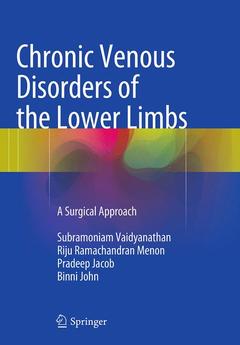Description
Chronic Venous Disorders of the Lower Limbs, Softcover reprint of the original 1st ed. 2015
A Surgical Approach
Authors: Vaidyanathan Subramoniam, Menon Riju Ramachandran, Jacob Pradeep, John Binni
Language: English
Subject for Chronic Venous Disorders of the Lower Limbs:
Approximative price 94.94 €
In Print (Delivery period: 15 days).
Add to cartPublication date: 09-2016
Support: Print on demand
Approximative price 105.49 €
In Print (Delivery period: 15 days).
Add to cartPublication date: 10-2014
233 p. · 17.8x25.4 cm · Hardback
Description
/li>Contents
/li>Biography
/li>Comment
/li>
Section I - Basics Chapter 1 Venous diseases - a historical survey .- Chapter 2 - Lower limb venous anatomy.
.- Chapter 3 - Venous physiology and haemodynamics of lower limbs .- Chapter 4 - Chronic venous disorders. Classification , severity assessment and nomenclature.
Section II - Primary varicose veins -C2 clinical class
.- Chapter 5 - Epidemiology and risk factors.- Chapter 6 - Primary varicose veins : symptoms and diagnosis .- Chapter 7 - Open surgery for primary varicose veins.- Chapter 8 - Endovenous thermal ablation.
.- Chapter 9 - Sclerotherapy. - Chapter 10 - Recurrent varicose veinsSection III - Chronic venous insufficiency and leg ulcer - C3-C6 clinical class.- Chapter 11 - Chronic venous insufficiency and venous ulcers: pathophysiology .- Chapter 12 - Chronic venous insufficiency - clinical features and investigations.- Chapter 13 - Principles of treatment of chronic venous insufficiency.- Chapter 14 - The post-thrombotic syndrome. Pathophysiology, clinical features and management .- Chapter 15 - Care of ulcer and compression therapy .- Chapter 16 - Pharmacotherapy of CVI.- Chapter 17 - Strategies for the management of incompetent perforating veins.- Chapter 18 - Deep vein valve reconstruction.-
Chapter 19 - Deep vein obstruction - management strategies
Section IV - Assorted venous problems
.- Chapter 20 - Venous telangiectasia and reticular veins- Clinical class CI.- Chapter 21 - Pelvic venous syndromes.
.- Chapter 22 - Non thrombotic iliac vein lesion (May Thurner syndrome).- Chapter 23 - Klippel Trenaunay Syndrome.
Educational Qualification: M.B.B.S., University of Kerala, 1967 M.S. (General Surgery) University of Kerala, March 1973
Teaching Experience: Tutor in Surgery, 23.04.1973 to 09.12.1975 Assistant Professor in Surgery, 09.12.1975 to 11.06.1993 Associate Professor of Surgery, 11.06.1993 to 14.08.1996 Professor of Surgery, 15.08.1996 to 30.04.2001 Additional Training: 1. Training in non-invasive evaluation of venous disease of lower limbs and Vein Valve Reconstruction at the University of Mississippi under Dr. Seshadri Raju 2. Ambulatory Venous Pressure Studies of the lower limbs.
Comprehensive coverage including clinical features, evaluation and management
Covers all recent developments in the diagnosis and treatment options
Includes latest techniques such as minimally invasive approach and radio-frequency therapy
These books may interest you

Vascular Surgery: Current Concepts and Treatments for Venous Disease, An Issue of Surgical Clinics 102.68 €

Venous DisordersCurrent Concepts 126.59 €

A Treatise on Venous Diseases 57.35 €

